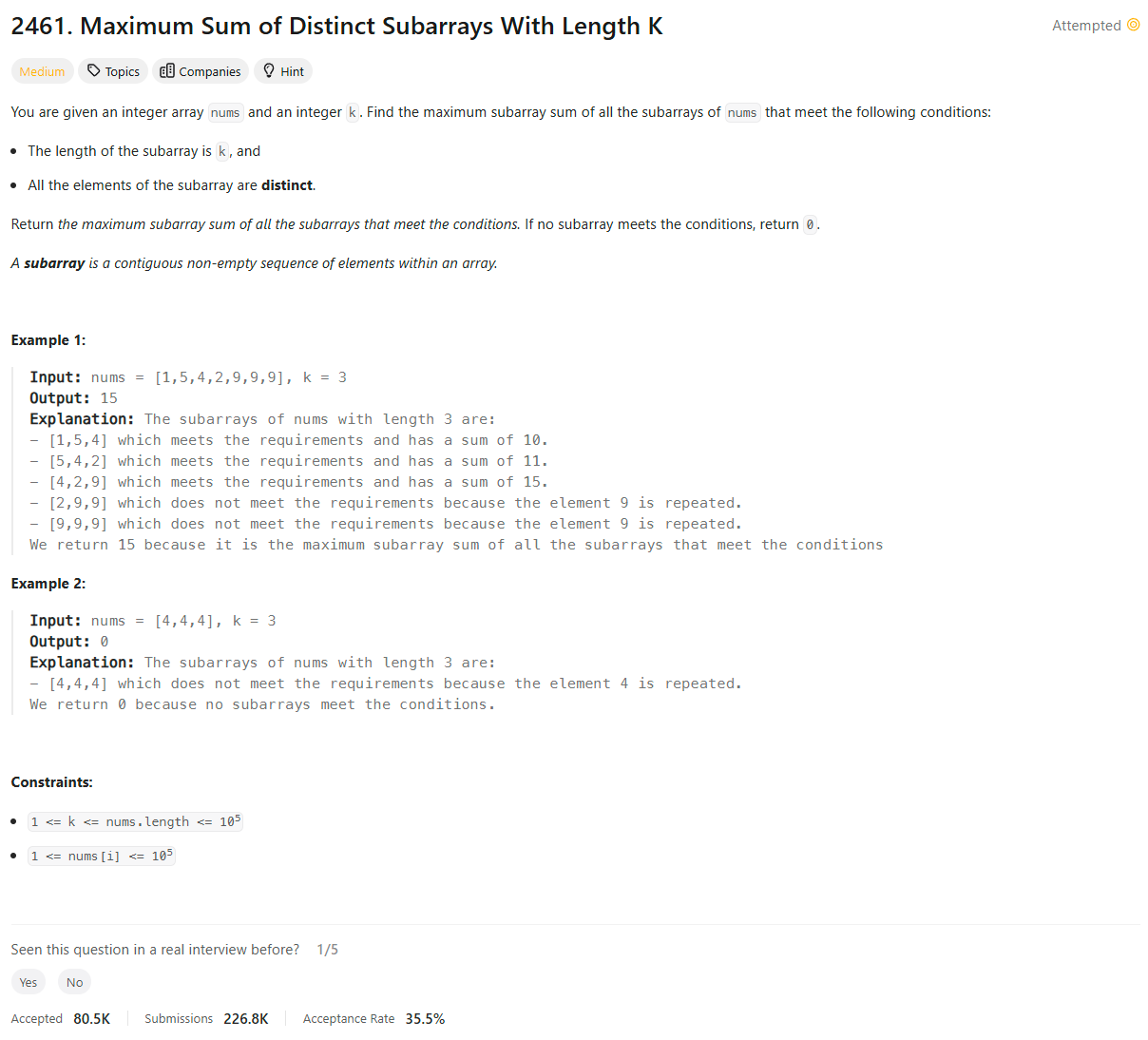Problem of The Day: Maximum Sum of Distinct Subarrays With Length K
Problem Statement

Brute Force [TLE]
class Solution:
def maximumSubarraySum(self, nums: List[int], k: int) -> int:
start, end = 0, k - 1
N = len(nums)
res = 0
arr = deque()
curr_sum = 0
for i in range(k):
arr.append(nums[i])
curr_sum += nums[i]
for end in range(k, N):
if len(set(arr)) == k:
res = max(res, curr_sum)
curr_sum -= nums[start]
start += 1
arr.popleft()
arr.append(nums[end])
curr_sum += nums[end]
if len(set(arr)) == k:
res = max(res, curr_sum)
return res
Intuition
The goal is to find the maximum sum of a subarray of size k in a given list, ensuring that all elements in the subarray are unique. To achieve this, a sliding window approach can efficiently track subarray sums and uniqueness constraints.
Approach
-
Sliding Window Technique:
Use two pointers (startandend) to maintain a window of size at mostk. Adjust the window dynamically based on conditions:- If a duplicate element is found within the window, move the
startpointer to exclude the earlier occurrence of the duplicate, updating the current sum and hash map accordingly. - If the window size equals
k, compute the maximum sum and shrink the window by moving thestartpointer forward.
- If a duplicate element is found within the window, move the
-
Tracking Uniqueness:
A hash map (hash_map) is used to store the most recent index of each element in the current window. This helps quickly identify and handle duplicates. -
Maintaining the Current Sum:
A variable (curr_sum) tracks the sum of the current window. When the window changes (e.g., due to duplicates or exceeding sizek), the sum is adjusted by subtracting the values of excluded elements. -
Result Calculation:
Continuously update the result (res) with the maximum sum encountered when the window size equalsk.
Complexity
-
Time Complexity:
\(O(n)\)
Each element is processed at most twice (once when entering the window and once when exiting). -
Space Complexity:
\(O(k)\)
The hash map and the sliding window can hold up tokelements.
Code
class Solution:
def maximumSubarraySum(self, nums: List[int], k: int) -> int:
start, end = 0, k - 1
N = len(nums)
res = 0
curr_sum = 0
hash_map = defaultdict(int)
for end in range(N):
# Handle duplicates
if nums[end] in hash_map:
index = hash_map[nums[end]]
for i in range(start, index + 1):
curr_sum -= nums[i]
if nums[i] in hash_map:
del hash_map[nums[i]]
start = index + 1
# Update current window
hash_map[nums[end]] = end
curr_sum += nums[end]
# Check if window size equals k
if end - start + 1 == k:
res = max(res, curr_sum)
curr_sum -= nums[start]
if nums[start] in hash_map:
del hash_map[nums[start]]
start += 1
return res
Editorial
Approach: Sliding Window
class Solution:
def maximumSubarraySum(self, nums: List[int], k: int) -> int:
ans = 0
current_sum = 0
begin = 0
end = 0
num_to_index = {}
while end < len(nums):
curr_num = nums[end]
last_occurrence = num_to_index.get(curr_num, -1)
# if current window already has number or if window is too big, adjust window
while begin <= last_occurrence or end - begin + 1 > k:
current_sum -= nums[begin]
begin += 1
num_to_index[curr_num] = end
current_sum += nums[end]
if end - begin + 1 == k:
ans = max(ans, current_sum)
end += 1
return ans
- time: O(N)
- space: O(N)